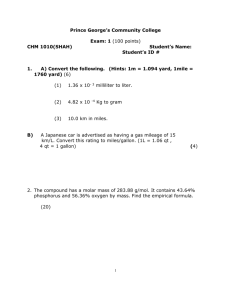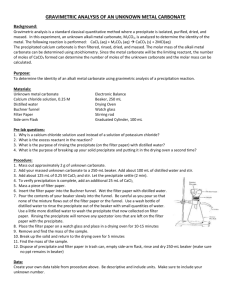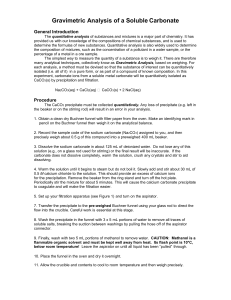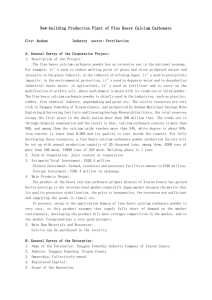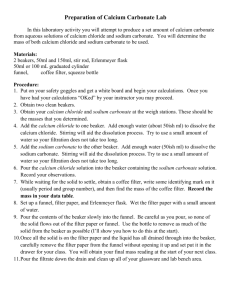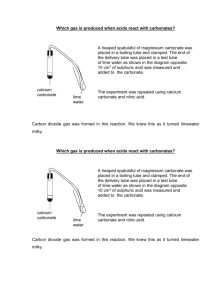Gravimetric Analysis of a Metal Carbonate
advertisement
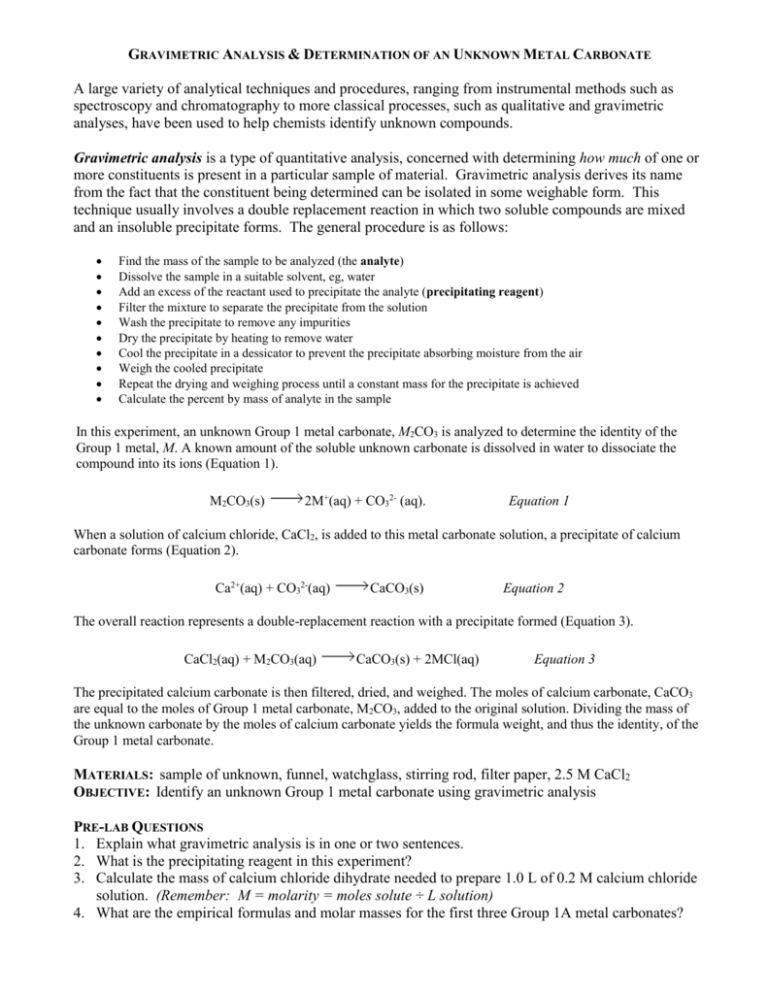
GRAVIMETRIC ANALYSIS & DETERMINATION OF AN UNKNOWN METAL CARBONATE A large variety of analytical techniques and procedures, ranging from instrumental methods such as spectroscopy and chromatography to more classical processes, such as qualitative and gravimetric analyses, have been used to help chemists identify unknown compounds. Gravimetric analysis is a type of quantitative analysis, concerned with determining how much of one or more constituents is present in a particular sample of material. Gravimetric analysis derives its name from the fact that the constituent being determined can be isolated in some weighable form. This technique usually involves a double replacement reaction in which two soluble compounds are mixed and an insoluble precipitate forms. The general procedure is as follows: Find the mass of the sample to be analyzed (the analyte) Dissolve the sample in a suitable solvent, eg, water Add an excess of the reactant used to precipitate the analyte (precipitating reagent) Filter the mixture to separate the precipitate from the solution Wash the precipitate to remove any impurities Dry the precipitate by heating to remove water Cool the precipitate in a dessicator to prevent the precipitate absorbing moisture from the air Weigh the cooled precipitate Repeat the drying and weighing process until a constant mass for the precipitate is achieved Calculate the percent by mass of analyte in the sample In this experiment, an unknown Group 1 metal carbonate, M2CO3 is analyzed to determine the identity of the Group 1 metal, M. A known amount of the soluble unknown carbonate is dissolved in water to dissociate the compound into its ions (Equation 1). M2CO3(s) 2M+(aq) + CO32- (aq). Equation 1 When a solution of calcium chloride, CaCl2, is added to this metal carbonate solution, a precipitate of calcium carbonate forms (Equation 2). Ca2+(aq) + CO32-(aq) CaCO3(s) Equation 2 The overall reaction represents a double-replacement reaction with a precipitate formed (Equation 3). CaCl2(aq) + M2CO3(aq) CaCO3(s) + 2MCl(aq) Equation 3 The precipitated calcium carbonate is then filtered, dried, and weighed. The moles of calcium carbonate, CaCO3 are equal to the moles of Group 1 metal carbonate, M2CO3, added to the original solution. Dividing the mass of the unknown carbonate by the moles of calcium carbonate yields the formula weight, and thus the identity, of the Group 1 metal carbonate. MATERIALS: sample of unknown, funnel, watchglass, stirring rod, filter paper, 2.5 M CaCl2 OBJECTIVE: Identify an unknown Group 1 metal carbonate using gravimetric analysis PRE-LAB QUESTIONS 1. Explain what gravimetric analysis is in one or two sentences. 2. What is the precipitating reagent in this experiment? 3. Calculate the mass of calcium chloride dihydrate needed to prepare 1.0 L of 0.2 M calcium chloride solution. (Remember: M = molarity = moles solute ÷ L solution) 4. What are the empirical formulas and molar masses for the first three Group 1A metal carbonates? 5. An anhydrous carbonate salt of an unknown Group 1 metal was analyzed gravimetrically. A student recorded the following data: mass of crucible 10.655 g mass of crucible + M2CO3 12.133 g mass of filter paper 0.598 g mass of filter paper + dried CaCO3 2.436 g (a) Calculate the grams of anhydrous salt in the sample. Hint: grams anhydrous salt = (mass of crucible + M2CO3) – mass of crucible (b) Calculate the mass of calcium carbonate precipitated. Use this to find the moles of calcium carbonate. Hint: grams CaCO3 = (mass of filter paper + dried CaCO3) – mass of filter paper moles CaCO3 = grams CaCO3 ÷ molar mass of CaCO3 (c) Calculate the molar mass of the unknown M2CO3. Hint: molar mass of M2CO3 = grams anhydrous salt ÷ moles CaCO3 (d) What is the identity of the unknown metal carbonate? (e) Calculate the percent error of the experimental molar mass of the unknown metal carbonate. PROCEDURE: 1. Mass ~1 g of the metal carbonate in a 100 mL beaker. 2. Add about 20 mL of distilled water to the beaker and stir to dissolve the unknown carbonate. 3. Measure about 20 mL of calcium chloride solution. Add the CaCl2 solution to the metal carbonate in the 100 mL beaker and stir w/ glass rod. Allow the precipitate to settle for ~5 minutes. 4. Attach a clamp to an iron ringstand. Place a funnel securely in the clamp. Label a piece of filter paper with your initials near the edge. Mass the filter paper, record, and fold as instructed into the funnel. Place another 100 mL beaker below the funnel to filter into. 5. Decant (pour off) the liquid from the precipitation reaction into the filter using a stirring rod. Make sure the liquid level stays below the top of the filter paper (be careful not to pour over your initials). When all but about 10 mL of the liquid has been transferred, swirl the beaker to suspend the precipitated calcium carbonate. Transfer the suspension into the filter. Rinse the precipitation beaker with distilled water. Transfer the rinse water into the filter. Repeat steps (d) and (e) until all of the precipitate has been transferred onto the filter paper. 6. Carefully remove the filter paper from the funnel with the scoop. Carefully move the filter paper to a watchglass. Open the filter paper. 7. Place the watchglass and filter paper in the drying oven. After 10-15 minutes of heating, remove the watchglass and filter paper. Use the microscoop to break up the calcium carbonate into smaller particles. Dry in the drying oven for an additional 5 minutes. 8. Mass the cooled precipitate and filter paper. Repeat Step 8 until the mass remains constant. 9. Clean up: The filtrate (solution that passed through the filter) may be poured down the drain with water. Place the calcium carbonate in the designated beaker. The filter paper may be placed in the garbage. DATA Trial 1 Trial 2 Mass of unknown (g) Mass of filter paper (g) Mass of filter paper with dried analyte (CaCO3) (g) Mass of CaCO3 (g) Moles of CaCO3 (mol) Moles of unknown (mol) Molar mass of unknown (g/mol) Formula of the unknown metal carbonate ANALYSIS Show calculations on a separate sheet and attach. Record answers to calculations in the data table above. 1. 2. 3. 4. Calculate the moles of precipitated calcium carbonate. Calculate the molar mass of the unknown. (Remember, moles CaCO3 = moles M2CO3) Identify the unknown carbonate. Explain your reasoning. Now that you have identified the unknown metal in the metal carbonate, write the equation for the metal carbonate dissolving in water. Include states (s, l, g, aq). 5. Write the full equation for the double replacement reaction that occurs between the calcium chloride and the metal carbonate in solution. Include states. What ions are present in the filtrate? 6. The net ionic equation shows only those ions that react with one another to form a precipitate (insoluble solid). Write the net ionic equation for the reaction in question #5. Include states. 7. Calculate the percent error for the molar mass of your unknown. DISCUSSION & CONCLUSION In this section, be sure to discuss any theories, laws, or major concepts that were illustrated in this lab. Also include possible sources of error and answers to the following questions. (a) How would the experimental molar mass of your unknown be affected if an insufficient amount of CaCl2 (aq) was added to your metal carbonate solution? (b) How would the experimental molar mass of your unknown be affected if the CaCO3 (analyte) was not completely dried?
